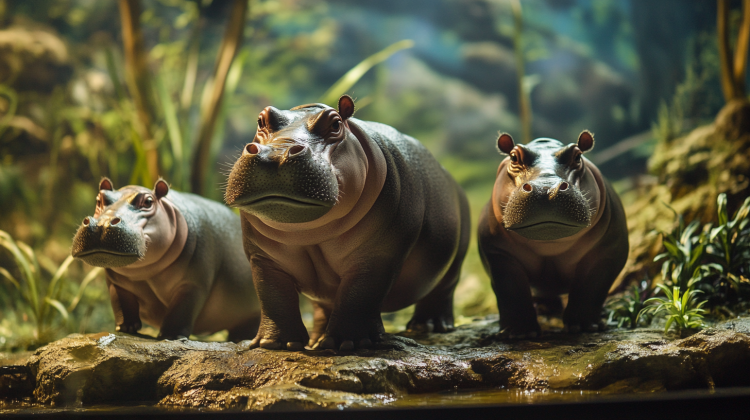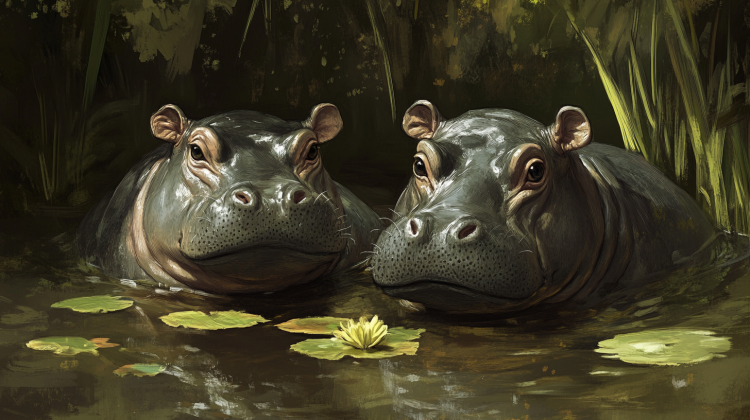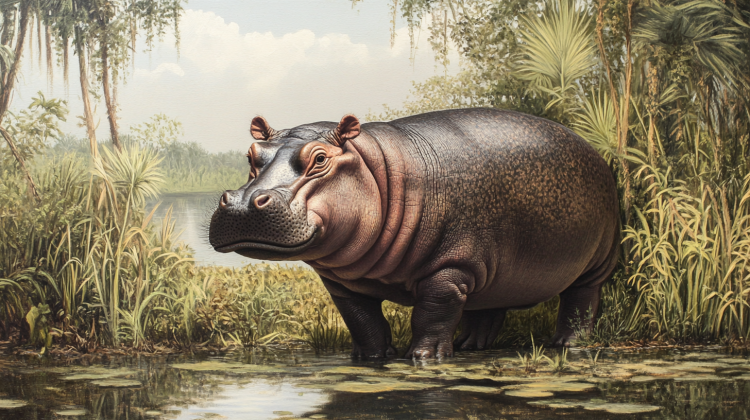

The pygmy hippopotamus (Choeropsis liberiensis) is a shy, elusive creature that has captured the hearts of animal enthusiasts worldwide. Unlike its much larger relative, the common hippopotamus, the pygmy hippo is a smaller and more solitary species that thrives in the dense forests and swamps of West Africa. With its unique characteristics and vulnerable status, the pygmy hippo is a fascinating species that deserves attention and protection.
In this blog post, we’ll dive into everything you need to know about pygmy hippos, from their habitats and behavior to their conservation status.
What Are Pygmy Hippos?
Pygmy hippos are semi-aquatic mammals native to the forests and swamps of West Africa, specifically in countries like Liberia, Sierra Leone, Guinea, and the Ivory Coast. They belong to the same family as the common hippo but are significantly smaller, weighing between 400 and 600 pounds and standing only about 2.5 to 3 feet tall at the shoulder.
These fascinating creatures are perfectly adapted to their environment. Their sleek bodies and webbed feet allow them to move easily through water, while their skin produces a special substance called “blood sweat” to keep it moisturized and protected from the sun and infections.
Key Differences Between Pygmy Hippos and Common Hippos
While pygmy hippos and common hippos share some similarities, they differ in several important ways:
- Size: Pygmy hippos are about one-fifth the size of common hippos.
- Behavior: Pygmy hippos are solitary or live in pairs, unlike the highly social common hippos that live in large groups called pods.
- Habitat: While common hippos prefer open rivers and lakes, pygmy hippos are adapted to forested swamps and rivers.
- Appearance: Pygmy hippos have a sleeker body and proportionally longer legs compared to their larger relatives.


Habitat and Lifestyle
Pygmy hippos are most active at night, making them nocturnal animals. They spend their nights foraging for food, feeding primarily on leaves, fruits, grasses, and ferns. During the day, they retreat to water bodies to stay cool and avoid predators. Their dense forest habitat provides plenty of cover, helping them stay hidden from threats.
Unlike common hippos, which are highly territorial and aggressive, pygmy hippos are much more reserved and avoid confrontation whenever possible. Their solitary nature helps them navigate the dense forest without much competition for resources.
Pygmy Hippo Reproduction
Pygmy hippos typically mate in the water, and females give birth to a single calf after a gestation period of around six to seven months. Calves are born weighing about 10 to 14 pounds and are able to swim almost immediately. Mothers are highly protective of their young, keeping them close while they nurse and learn to navigate their forest habitat.
Conservation Status
The pygmy hippo is currently listed as Endangered by the International Union for Conservation of Nature (IUCN). It is estimated that fewer than 2,500 individuals remain in the wild. Their numbers continue to decline due to threats such as:
- Habitat Loss: Logging, agriculture, and human settlements are destroying the dense forests and swamps that pygmy hippos rely on for survival.
- Hunting: Pygmy hippos are hunted for their meat, despite being protected in many regions.
- Climate Change: Rising temperatures and changes in rainfall patterns threaten their already limited habitat.
Conservation efforts are underway to protect pygmy hippos, including habitat preservation, anti-poaching measures, and breeding programs in zoos. Organizations like the Pygmy Hippo Foundation are working tirelessly to raise awareness and ensure the survival of this unique species.
Why Pygmy Hippos Matter
Pygmy hippos play an important role in their ecosystem. As they forage for food, they help disperse seeds and promote plant growth in their habitat. Their presence also indicates a healthy forest ecosystem, as they rely on clean water and abundant vegetation to survive.
Beyond their ecological role, pygmy hippos are a symbol of West Africa’s rich biodiversity and serve as ambassadors for the protection of other forest-dwelling species.
How You Can Help
You don’t have to live in West Africa to make a difference for pygmy hippos. Here are some ways you can contribute to their conservation:
- Support Conservation Organizations: Donate to or volunteer with groups that protect pygmy hippos and their habitats, such as the Pygmy Hippo Foundation or World Wildlife Fund (WWF).
- Raise Awareness: Share information about pygmy hippos with others to highlight their plight and the importance of protecting them.
- Choose Sustainable Products: Avoid products linked to deforestation, such as unsustainable palm oil or hardwoods.


Fascinating Facts About Pygmy Hippos
- Pygmy hippos are more closely related to whales and dolphins than to other land mammals.
- They can hold their breath underwater for up to five minutes.
- Their skin secretes a pinkish, oily substance often referred to as “blood sweat,” which acts as sunscreen and an antiseptic.
- Pygmy hippos are excellent swimmers and can even close their nostrils underwater to keep out water.
Protecting Pygmy Hippos for Future Generations
Pygmy hippos are remarkable creatures that highlight the beauty and diversity of our planet’s wildlife. Their shy, solitary nature makes them hard to study, but it also underscores the importance of protecting their dwindling populations. By supporting conservation efforts and raising awareness, we can help ensure that future generations get the chance to marvel at these gentle forest dwellers.
Let’s work together to preserve the pygmy hippo’s habitat and ensure its place in the wild for years to come.
Certainly! Here are additional sections and details that could enhance the article:
Cultural Significance of Pygmy Hippos
In the regions where they are found, pygmy hippos hold cultural importance for local communities. In Liberia, for example, they are sometimes featured in folklore and are considered shy, mystical creatures of the forest. Their elusive nature has earned them a place in local legends, where they are often regarded with respect and awe.
In some areas, pygmy hippos have been associated with water spirits due to their aquatic tendencies and secretive behavior. Understanding and preserving these cultural connections can play a vital role in fostering local support for conservation initiatives.
Challenges in Studying Pygmy Hippos
Due to their nocturnal habits and preference for dense forests, pygmy hippos are notoriously difficult to study in the wild. Researchers rely on camera traps, tracks, and scat analysis to monitor their populations and behavior. These methods, while effective, are time-consuming and limited in scope. This lack of comprehensive data makes it harder to implement effective conservation strategies, highlighting the need for ongoing research and funding.
Zoos and Captive Breeding Programs
Zoos around the world are playing a significant role in protecting pygmy hippos through captive breeding programs. These programs not only aim to increase their numbers but also provide valuable opportunities for education and awareness. Successful breeding efforts in institutions like the San Diego Zoo and the London Zoo have helped raise public interest in pygmy hippos and their conservation.
Zoos also contribute to research by studying pygmy hippos’ behavior, diet, and health, providing insights that can be applied to wild populations. Many zoos collaborate with conservation organizations to fund habitat protection efforts in West Africa.
How Pygmy Hippos Adapt to Their Environment
Pygmy hippos have developed unique adaptations to thrive in their swampy, forested habitats:
- Streamlined Bodies: Their smaller, more streamlined shape allows them to move efficiently through dense vegetation and water.
- Webbed Feet: Unlike their larger relatives, pygmy hippos have partially webbed toes, which help them navigate muddy terrain and swim.
- Sensitive Skin: Their skin is highly sensitive to drying out, which is why they spend much of their time in water or shaded areas to stay cool and hydrated.
- Herbivorous Diet: Pygmy hippos are highly adaptable in their feeding habits, consuming a variety of plants, fruits, and ferns available in their habitat.
Success Stories in Conservation
Though challenges remain, there have been some successes in pygmy hippo conservation. Protected areas like Sapo National Park in Liberia provide a safe haven for pygmy hippos, where conservationists work to minimize threats like hunting and deforestation. Community-based initiatives in these regions are also gaining traction, empowering locals to take part in habitat preservation and wildlife monitoring.
Additionally, public awareness campaigns have been instrumental in reducing hunting and promoting sustainable practices in areas near pygmy hippo habitats.
The Role of Ecotourism
Ecotourism could play a vital role in the conservation of pygmy hippos. By promoting responsible travel to regions where they are found, local communities can benefit economically while preserving the forests and swamps that these animals call home. Tourists interested in spotting pygmy hippos can also contribute by supporting conservation-focused lodges and programs.





